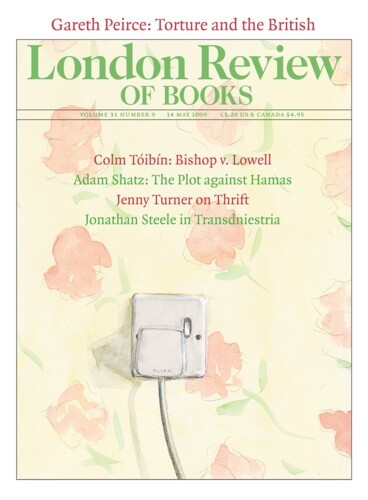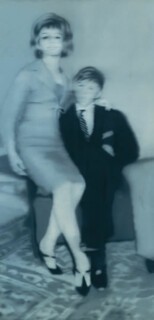You never doubt that Gerhard Richter’s portraits (an exhibition of them runs at the National Portrait Gallery until 31 May) are pictures of photographs. Pictures of photographs, not pictures based on photographs, which is how you would describe them if the photograph took the place of a preparatory drawing. The effect is nothing like that of a painting which, placed alongside its sources, shows how the cleverness you took pleasure in was a more mechanical thing than you imagined. In that case the use of photographs seems like a cheat. Nor are Richter’s portraits based on photographs in the way caricatures sometimes are, when you can recognise the image used, but sinuous outlines, hatchings and simplifications bury the photograph as artefact. Richter’s portraits are pictures of photographs in the way The Hay Wain is a picture of a landscape.
Even when very like the photographs they are based on, they are not uninflected reproductions. Reader (1994), when seen in the catalogue, looks exactly like the small colour print it derives from.* But it takes on a different life as a real, painted canvas. The evidence, in each part, of the activity of a human hand transforms something that had its beginning in the snatched, restless world of casual photography into a work that takes its place easily in a world of slower, longer looking.
Yet it is precisely photography’s swift restlessness, its ability to capture views of scenes or people that change as one fraction of a second follows another, views always there but unknown before it was possible to freeze them with a camera shutter, that gives Richter’s portraits from the 1960s – the later ones are much more ‘composed’ – their particular quality. Mother and Daughter (B) (1965) shows two women walking towards you; Terese Andeszka (1964) shows a man and woman with a child holding a beach ball between them. Both are rather painterly and even in reproduction you would never mistake them for photographs. But you also know, immediately, that only a photograph could be the basis of the poses, the fall of light and shade, the gawkiness of it all. As soon as a human being decides to paint a picture he or she is landed with problems. Replace the usual preliminaries with a photograph and things become easier. ‘Do you know what was great?’ Richter said:
Finding out that a stupid, ridiculous thing like copying a postcard could lead to a picture. And then the freedom to paint what you felt like. Stags, aircraft, secretaries. Not having to invent anything any more, forgetting everything you meant by painting – colour, composition, space – and all the things you previously knew and thought. Suddenly none of this was a prior necessity for art.
Richter’s awareness of the change that takes place when a photograph becomes a picture and a picture then becomes a photographic illustration is acknowledged in the exhibition by a display mounted in the National Portrait Gallery entrance hall of photographs of 48 Portraits – oil paintings of famous men, themselves taken from photographs in an encyclopedia.
Richter’s photographic starting points are old and new snapshots, newspaper illustrations, advertisements and, for the more recent portraits, his own photographs. In making his pictures of pictures he often softens or blurs the image. Reproductions, particularly small ones, hide the way this is done. Horizontal dragged striations make Mother and Daughter (B) and many other 1960s pictures look like screen grabs from an old television set, or wired pictures from the early days of facsimile transmission. It’s hard to work out exactly how the effect was achieved but it looks as though the paint when wet was gone over with a dry, stiff brush. There is a reproduction in the catalogue of The Family at the Seaside (1964), a monochrome group of mother, father and children with the sea behind. It is strongly painted, not blurred at all, and you can imagine some of the blurred, striated images beginning life looking very like it. The unblurred state of Reader suggests what other late paintings were like before the original transcription was feathered, scratched or scraped. ‘I blur things,’ Richter said early on, ‘to make everything equally important and equally unimportant. I blur things so that they do not look artistic or craftsmanlike but technological, smooth and perfect. I blur things to make all the parts a closer fit. Perhaps I also blur out the excess of unimportant information.’ By the time you get to the 1990s and 2000s blur control has become more sophisticated, more delicate – in some cases mannered. In the early Terese Andeszka the black and white pattern on the woman’s bikini is painted in strong black and white, and pleasure has been taken in the thickness and opacity of the white paint that outlines the figure on the right. The feathered contours of S with Child (1995) turn a Mary Cassatt subject into something oddly like an early colour photograph – one of Edward Steichen’s autochromes, perhaps.
Richter has made paintings of many kinds, so an exhibition like this one, of portraits alone, is a simplification. The scene is narrowed, there is no abstract painting, and some themes, in particular German history in his lifetime, become noises off. But it is not a minor exhibition and the paintings are things to wonder at. Some are odd, some disturbing or strange, some tender; they are, as handmade objects, beautiful. Because they span a lifetime (the earliest were made in the mid-1960s, the latest in 2007), and because they follow the same route to the canvas as his other pictures, they show you the whole painter.
The effect they have can’t be separated from the place other images have had and still have in one’s mind. In the early 1900s the artful blur was a regular tool used by photographers who wished to raise the aesthetic status of their craft. The utterly unartful, not quite readable snapshot is often the only available picture when a person goes missing. The earliest memories anyone has may be an amalgam of what is truly remembered and what is only known from a faded print. The worst atrocities (Richter elsewhere found that some things were beyond the reach of painting) may be recorded in the same little album formats as seaside holidays. You do not need to know who the subjects of Richter’s portraits are: although the paintings show his wives, children, friends, colleagues and fellow artists, as well as many anonymous figures, they reach you by bringing to mind blurred images of your own.
In Richter’s portrait-making, looking at photographs has taken the place of looking at the world. The quality of the marks that record the image is as central to the force of his portraits as it is to that of any abstract painting. Richter’s remarkable achievement has been to finesse photography’s challenge to figuration and transform mechanical records into personal creations.
Send Letters To:
The Editor
London Review of Books,
28 Little Russell Street
London, WC1A 2HN
letters@lrb.co.uk
Please include name, address, and a telephone number.


